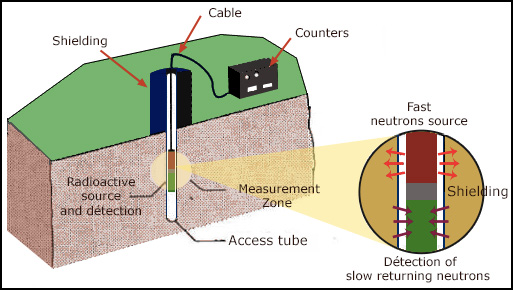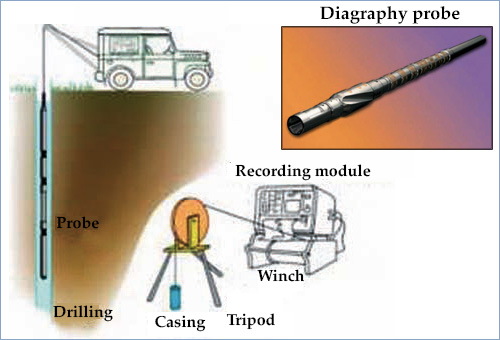
Steel control by X-fluorescence
A radioactive source is used to bombard a steel pellet whose composition is to be checked. Upon penetrating the sample, the rays excite the inner layers of the metal atoms, causing the emission of characteristic X-rays. Some of these rays emerge from the surface and can be detected. In the example of the figure, molybdenum (Mo), chromium (Cr) and nickel (Ni) X-rays are identified alongside the predominant iron X-rays.
© DR
Because of the fears it inspires, radioactivity is considered in the collective unconscious as hostile to the environment. However, well mastered, it helps to improve it thanks to precious controls.
One example is the air quality and dust content monitoring of factory releases. To measure the degree of dust resulting from these releases, the air is constantly filtered on a ribbon running between a radioactive source and a detector. The intensity of the radiation received by the detector depends on the dust deposited on the filter. This makes it possible to determine this rate and take the necessary measures if the degree of dust is too high.
Radioactive gauges play a similar watchdog role in the coal industry, which accounts for more than half of the world’s electricity production. Some neutron emitting gauges (typically americium-241 and berylium) measure and control the moisture present in coal and coke. Others, which emitting gamma rays, are used to ascertain the composition of the ashes and of the combustion gases coming out of the chimneys. It is important to limit the amount of sulfides and nitrides present in these gases and ashes, because of the negative role these contaminants play in acid rains.
More generally and apart from environmental considerations, it is necessary in many industrial processes to determine the composition of minerals or materials used in products manufacturing. The property of X-ray fluorescence (emission of characteristic X-rays by atoms under the effect of radiation) is often used to this effect. For instance, this helps to guarantee the constant quality of a steel coating or to follow the good progress of a chemical process. A combination of radiation filters can be used to sort the X-rays and facilitate the identification of the atoms present in a complex mixture of minerals or components.
Radioactive sources are used as diagnostic tools during refining operations which constitute an important part of the petroleum industry. As it is difficult to introduce and maintain probes inside the distillation towers whereextreme conditions prevail, gamma probes can be installed outside the towers and moved vertically to follow the liquid levels inside, record the composition of the ingredients at various heights and detect malfunctions.

Principle of moisture and hydrocarbon research
Water and hydrocarbons are rich in hydrogen, the most efficient nucleus able to slow down neutrons. To measure the amount of hydrogen underground, a probe is introduced with a source of neutrons which delivers brief pulses of fast neutrons into the soil. The source is associated with a slow neutron detector. The abundance of hydrogen-rich materials is measured by the flow of slow neutrons returning detected shortly after the pulse.
© Melonou
In geology and in particular for petroleum prospecting, radioactive sources are used for exploring the properties of soils, to measure their density or detect the presence of water or hydrocarbons.

Diagraphy principle
A diagraphy consists in characterizing, after a drilling, the characteristics of the drilled rocks, using different probes. Some diagraphies use gamma or neutron sources placed in the probe. There are « logging while drilling « , when the characteristics are recorded during drilling. There are also deferred logs, the characteristics of the formation being recorded a posteriori after the drilling,
© ASN
Diagraphy or « well logging » allows to study the geological properties of undergrounds by introducing a probe including a gamma source (cobalt 60, césium 137 …) or a neutrons source (américium-béryllium ou de californium-252). In the first case, the gamma backscattering is used for density and composition measurements, in the second case the slowing down of the neutrons allows to detect the presence of hydrogen.
Other articles on the subject « Applications of Radioactivity »
Inspection and controls
A tool for testing and tune-ups The penetrating property of radiations is commonly used to check [...]
Material Developmnent
Improvements in the quality of industrial products Every day we make use of products that have be[...]
Non Destructive Testing
Control of industrial processes and materials Tracers and radioactive sources are frequently used[...]
Food processing
Eradicate bacteria, fungi and pests with radiation … Gamma rays are used industrially to en[...]
Food Preservation
Conservation and preservation of food The effects of radiation on the cells of living or vegetabl[...]
Conservation Effects
A conservation process without additives, non radioactive The biological effects of strong doses [...]
Medfly Eradication
The curse of the medfly and its eradication The Mediterranean flies or Medflies are a dreadful cu[...]
Disinfecting Effects
Getting rid of parasites and germs….. The radiobiological action of radiation leads to damage to [...]
Radioactive Gauges
Instruments for industrial process control In order to be peforming and efficient; modern industr[...]
Sources in Industry
A wide variety of applications Most radioelements in radioactive sources are extracted from small[...]